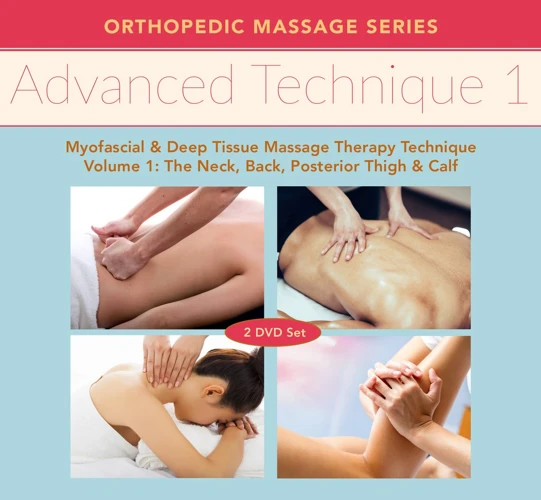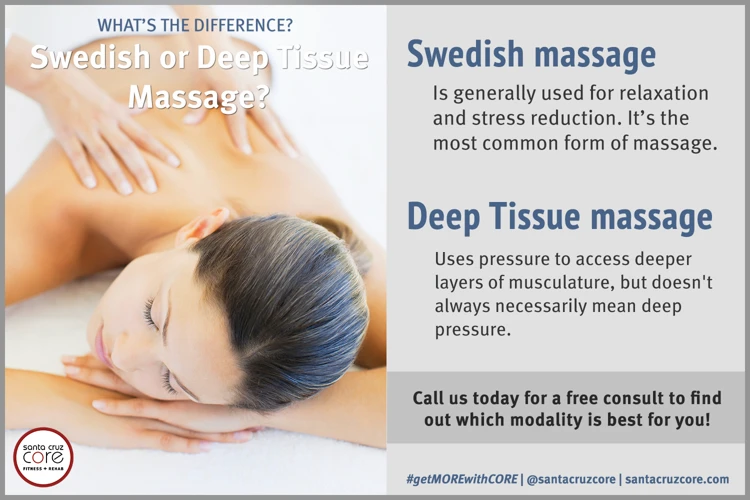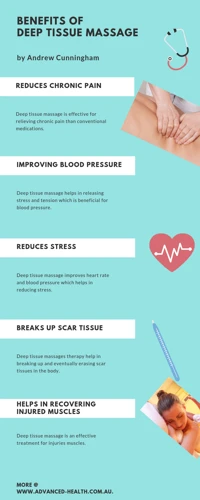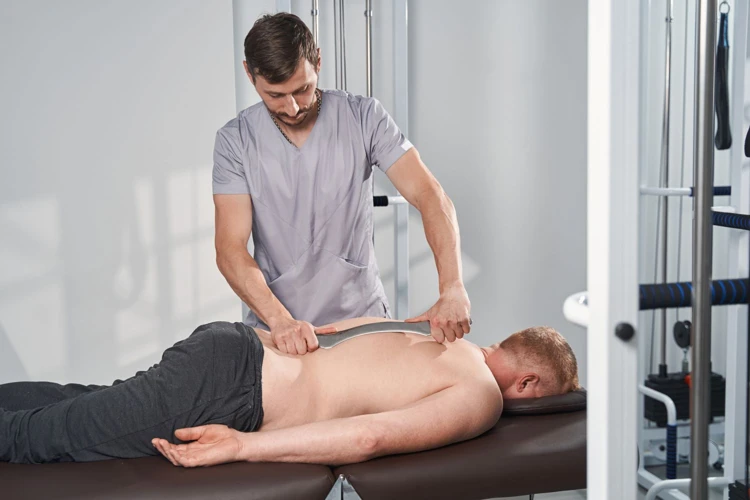Soft tissue massage is a type of massage therapy that focuses on the manipulation of soft tissues such as muscles, tendons, ligaments, and fascia. It is a hands-on technique that is used to treat a range of physical ailments, including back pain, neck pain, headaches, sports injuries, and more. In this article, we will discuss what soft tissue massage is, the benefits it offers, and the different techniques used to perform the massage.
Contents
What is Soft Tissue Massage

Definition
Soft tissue massage is a type of massage that focuses on the muscles and connective tissues of the body. This type of massage uses a variety of techniques to manipulate the soft tissues of the body to promote healing, improve range of motion and reduce pain.
Benefits
Soft tissue massage can provide a number of benefits, including improved circulation, reduced muscle tension, and improved range of motion. It can also reduce stress, promote relaxation, and reduce inflammation and swelling. Additionally, soft tissue massage can help to increase flexibility, reduce pain, and improve posture. As such, it is often used to treat a variety of musculoskeletal and soft tissue conditions, including sports injuries, back pain, and neck pain.
One of the most popular techniques used in soft tissue massage is the application of direct pressure. This technique involves the massage therapist using their hands to apply direct pressure to the affected area. This can help to reduce tension, increase circulation, and relieve pain. Other techniques used in soft tissue massage include stretching, friction, and kneading.
How to do Soft Tissue Massage
To perform soft tissue massage, the massage therapist will begin by assessing the affected area. This assessment will help to determine the type of massage and techniques that should be used. The therapist will then apply direct pressure or other techniques to the affected area to treat the condition. The massage should be done slowly and with a light touch. Additionally, the massage therapist should be aware of any pain or discomfort felt by the client, and adjust the massage accordingly. Soft tissue massage can be done on its own or as part of a larger treatment plan.
How to do Soft Tissue Massage

General Techniques
Soft tissue massage is a type of massage that focuses on the manipulation of soft tissues within the body. It is designed to improve range of motion, reduce tension, and improve circulation. It uses a combination of pressure and strokes to target the deeper layers of muscle and connective tissue. Generally, it involves kneading, rubbing, and tapping movements.
Specific Techniques
Effleurage: This is a gentle, light massage technique that helps to relax the muscles and increase circulation. It involves gliding strokes over the body using the palms, fingers, and thumbs.
Petrissage: This is a more intense massage technique that involves kneading, squeezing, and lifting of the muscles. It helps to break down knots, increase circulation, and promote relaxation.
Tapotement: This is a tapping massage technique that helps to relieve tension and improve circulation. It can be done with the fingers, palms, and even fists.
Friction: This massage technique involves the use of circular friction movements to help break down knots and stimulate circulation.
Vibration: This is a massage technique that uses vibrations to help relax the muscles and promote circulation. It can be done with the hands, fingers, or even a vibrating device.
What is Soft Massage

Definition
Soft tissue massage is a type of massage technique used to focus on the soft tissue structures of the body, such as the muscles, tendons and ligaments. It is designed to reduce tension, reduce pain and increase range of motion in the area being massaged.
Benefits
Soft tissue massage can provide a variety of benefits to the body, including improved muscle tone, increased flexibility and increased range of motion. It can also reduce pain, reduce stress, and improve circulation. Soft tissue massage can be used to treat a variety of medical conditions, including fibromyalgia, chronic pain, and post-surgical rehabilitation.
Advantages of Soft Tissue Massage

| Benefit | Description |
|---|---|
| Reduces Stress | Soft tissue massage can help to reduce stress and tension in the body, allowing the mind and body to relax. |
| Relieves Pain | Soft tissue massage can help to reduce and manage pain in the body. It can also help to increase flexibility and range of motion. |
| Improves Circulation | Soft tissue massage stimulates the circulatory system, allowing oxygen and nutrients to be delivered to the muscles and tissues more efficiently. |
| Improves Posture | Soft tissue massage can help to reduce muscular tightness, allowing for improved posture and better alignment of the spine. |
| Enhances Athletic Performance | Soft tissue massage can help to improve flexibility and reduce muscular tension, which can help athletes to perform better. |
Disadvantages of Soft Tissue Massage

- Risk of Injury – Soft Tissue Massage can cause minor to moderate injuries such as bruises, pulled muscles, and joint sprains. It is important to inform your practitioner of any existing injuries or medical conditions before the massage so they can adjust the pressure accordingly.
- Time Commitment – Soft Tissue Massage requires a significant time commitment. It typically requires regular treatments to achieve the desired results, which can be inconvenient for some people.
- Not Suitable for Everyone – Soft Tissue Massage is not suitable for people with certain medical conditions such as diabetes, cancer, and heart disease. It is important to consult a healthcare professional before engaging in any type of massage.
- Costs – Soft Tissue Massage can be expensive due to the time commitment required. It is important to research massage therapists in your area to ensure you get the best value for your money.
Safety Considerations for Soft Tissue Massage

Soft tissue massage therapy is generally considered safe when performed by a licensed, qualified massage therapist. However, there are certain health conditions that may be contraindicated, meaning they should not be massaged. These include:
- Pregnant women: Soft tissue massage should not be performed on pregnant women, as the risk of harm to the fetus outweighs any potential benefit.
- Infectious diseases: People with contagious diseases such as tuberculosis, hepatitis B, or HIV should not receive soft tissue massage.
- Recent surgery: Massage should not be performed on areas that have recently undergone surgery, as it may disrupt the healing process.
- Open wounds: Open wounds should not be massaged, as it can increase the risk of infection.
- Certain medications: Certain medications such as blood thinners or those used to treat cancer should not be taken before or after a soft tissue massage.
- Injured areas: Areas of the body that are injured or inflamed should not be massaged.
It is important to communicate with a massage therapist before and after a massage. This helps the therapist understand any health conditions or medications that could make the massage unsafe. The therapist should also be made aware of any areas of discomfort or pain before the massage begins.
Special Populations and Soft Tissue Massage
- Pregnant Women: Soft tissue massage can help reduce morning sickness, fatigue, headache, and lower back pain in pregnant women. It can also help improve the quality of sleep and reduce stress levels.
- Elderly: Soft tissue massage can help reduce pain, stiffness, and improve circulation in elderly people. It can also help improve balance and coordination.
- Children: Soft tissue massage can help reduce stress and anxiety in children, as well as improve their concentration and focus. It can also help promote a healthy lifestyle in children.
- Athletes: Soft tissue massage can help reduce muscle tension and fatigue in athletes. It can also help improve flexibility and range of motion, as well as reduce the risk of injury.
Frequently Asked Questions
What are the main benefits of soft tissue massage?
- Reduces Muscle Tension – Soft tissue massage helps to reduce muscle tension, which can often cause pain and discomfort. It can also help to improve muscle flexibility and range of motion.
- Improves Circulation – Soft tissue massage helps to improve the circulation of blood and lymph throughout the body, which can help to reduce inflammation and pain.
- Relieves Stress – Soft tissue massage can help to relieve stress and tension, both physical and mental, by promoting relaxation.
- Improves Posture – Soft tissue massage can help to improve posture by loosening tight muscles and increasing flexibility.
- Reduces Scar Tissue – Soft tissue massage can help to reduce the formation of scar tissue, which can be a common problem after surgery or an injury.
- Improves Mobility – Soft tissue massage can help to improve mobility and flexibility, which can help to prevent injuries.
How often should I receive a soft tissue massage?
It depends on the individual:
- If you have an acute injury, you may need several treatments close together
- If you have an ongoing issue that requires regular maintenance, you may need to receive a massage every week or two
- If you have a history of chronic pain or injury, you may want to receive a massage once a month
- If you are looking to receive a massage for relaxation and stress relief, you may want to receive a massage every few weeks or once a month
It is important to consult with your massage therapist to determine the best schedule for you. Your massage therapist can assess your individual needs and recommend the best frequency for you based on your goals and objectives.
What techniques are used for soft tissue massage?
- Swedish Massage: This is the most commonly used type of massage and involves long, gliding strokes along with kneading, tapping and friction movements.
- Trigger Point Massage: This type of massage focuses on specific areas of the body that are painful or have tension. It uses deep pressure to release the tension.
- Deep Tissue Massage: This type of massage uses slower, more-forceful strokes to target the deeper layers of muscle and connective tissue. It is used to break up scar tissue and physically break down muscle “knots”.
- Sports Massage: This type of massage is specifically designed for people who are involved in physical activity. It combines techniques to help warm up the muscle and increase flexibility.
- Myofascial Release: This technique focuses on releasing the fascia, which is the connective tissue surrounding muscles, nerves, and organs. It is used to help treat chronic pain and muscle tension.
- Shiatsu Massage: This type of massage originated in Japan and is based on the same principles as acupuncture. It uses finger pressure to target specific areas of the body.
Is Soft Tissue Massage Suitable for People with Certain Medical Conditions?
Soft tissue massage can be beneficial to many people, but it is not suitable for everyone. It should not be used on people with certain medical conditions such as cancer, blood clots, fractures, or any other condition where massage would be contraindicated. People with infectious skin disorders, open wounds, or severe osteoporosis should also avoid massage. It is important to check with a doctor prior to receiving a soft tissue massage.
What are the Potential Risks of Soft Tissue Massage?
Soft tissue massage can cause mild discomfort, especially for individuals who are new to massage. In some cases, the massage may cause bruising or other minor injuries. Additionally, individuals with certain medical conditions, such as those with clotting disorders, should not receive massage without consulting with their doctor first. People who have recently had surgery, fractures, or other serious medical conditions should also consult a doctor before receiving soft tissue massage.
Conclusion
Soft tissue massage is an effective technique for relieving muscle tension and promoting relaxation. It has a number of benefits, including pain relief, improved circulation, and improved range of motion. Practitioners can use a variety of techniques to achieve the desired results. It is important to choose a practitioner who is experienced and qualified to ensure the best possible results.

